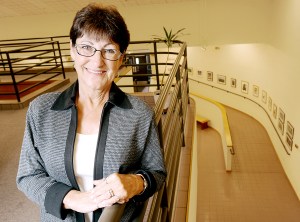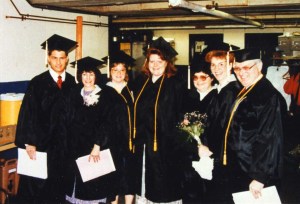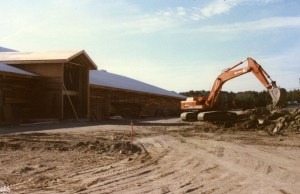LEWISTON — When Mary Sylvain-Leonas began studying for her four-year college degree, she was 41. She was supporting four children. And she’d spent her adult life working in shoe shops.
“Going to college was my dream,” said Sylvain-Leonas, who became one of the first students at the University of Southern Maine’s Lewiston-Auburn College.
“It was busy. It was chaotic,” she said. Many nights, after attending classes, working at a part-time campus job and caring for her children, she’d finish her homework at 3 or 4 a.m.
“But the end goal was always in sight,” she said.
In 1991, Sylvain-Leonas became part of L-A College’s inaugural class, earning a bachelor’s degree in social and behavioral sciences with eight other graduates.
Over the years, 1,299 people have followed with degrees ranging from the arts and humanities to nursing.
On Sept. 12, the school will celebrate its 25th anniversary. About 300 early graduates, faculty and politicians plan to gather.
“It’s hard to believe it’s been 25 years,” said Gregory Nadeau, who was a young Lewiston legislator in the 1980s.
When a study of the community’s economy found that local people had too little access to higher education, Nadeau and several other leaders latched on to the idea.
“The need wasn’t being met by the university system,” Nadeau said.
‘Fighting and pushing and leveraging’
Too many people were eager to enter school but were unable to drive to the closest University of Maine campuses in Portland and Augusta, the study found. Some people were attending Augusta’s satellite classes, held in the former Sacred Heart School in Auburn, but the best someone there could hope for was a two-year degree.
“In my 12 years as a legislator, there was no single issue I worked harder at,” said Nadeau, who now serves in Washington as deputy administrator of the Federal Highway Administration. “No one will dispute the benefit it has had and the impact it has had.”
Paul Dionne, Lewiston’s mayor at the time, agreed.
The university seemed to be present in so many towns — big and small — but seemed to bypass Lewiston, he said. Portland, Gorham, Orono, Farmington, Presque Isle, Machias and Fort Kent all had campuses.
“This is the second-largest population area in Maine; certainly, it deserved a university presence,” Dionne said. “There were a lot of roadblocks. There were a lot of obstacles. But everybody was very tenacious.”
Part of the problem was money. Legislators and then-Gov. Joseph Brennan were reluctant to spend state money on establishing a school in Lewiston.
They wanted $2 million from the city.
“We went to referendum twice to get the local contribution raised, without success,” Nadeau said. Some people argued that another campus was not needed.
Others said it was a matter of fairness. Since no other community had been forced to pay to establish a campus, why should Lewiston?
“We said, ‘We’re not going to be treated like second-class citizens anymore,'” said Jim Handy, who represented Lewiston in the Legislature for much of the 1980s. “We were able to convince the powers that be that we’re going to move on with a campus and get state funding for it.”
It worked.
“We ended up fighting and pushing and leveraging our way to success,” Nadeau said. “There was a point where we actually held up a university bond issue from passage until a commitment was made to pursue this.”
In 1987, the money was approved.
After examining 15 sites, including the former Peck Building on Main Street, decision-makers settled on the former Central Maine Tennis arena on Westminster Street. Work to transform the cavernous space into a school began in June 1988. Three months later, classes began.
Academic rigor
It didn’t look like a college campus.
“There was a lot of empty space,” Sylvain-Leonas said, recalling her first day of classes. “There were still tennis courts in the old section.”
She didn’t care, though.
“I loved it immediately,” she said.
Classmate Margaret Craven did, too.
“I couldn’t believe that they accepted me in a degree program,” said Craven, who now serves in the Maine Senate. “I was just amazed every day that I went there. At the time, I probably felt that I wasn’t fitting in all that well. But in retrospect, I was a very average student. A middle-aged woman, working, taking care of her kids and all of that. I was just struggling with the background I had.”
After growing up in Galway, Ireland, Craven had moved to New England as a teenager. She earned her high school diploma as an adult, taking classes at night. Before L-A College opened, she had taken a few college courses.
She was a nontraditional student, like so many the school was created to help. They were older. Many had careers and full-time jobs. But they wanted education.
Helping them was what drew Betty Robinson to join the faculty, even before there was a school.
Robinson, a sociologist, was working as an analyst for the Maine State Employees Association and was teaching off and on when the job came up. She liked that the curriculum was created to mix disciplines and that students were older, bringing their life experiences with them into the classroom.
She and public affairs professor Marvin Drucker became the school’s first two faculty members. They set a high bar for education at the school, surprising students and visitors by demanding academic rigor.
“The challenge is higher than one might expect,” Robinson said.
Six years after she started — and following a national search to replace founding dean Helen Greenwood — Robinson was promoted to dean.
She stayed in the role until 2003. She continues to teach part time at the school. And she’s proud of the high quality of the instruction.
“It was much better than anything I could have imagined,” she said.
The school has grown and grown.
The college now has 22 full-time faculty members. Since 1994, the facility has grown by 80 percent, with the addition of a second classroom building. Last spring, the college handed out 87 undergraduate degrees and 24 graduate degrees.
About 1,100 students are enrolled for the fall semester.
“It’s a fabulous campus,” said Craven, who went on to earn a master’s degree in adult education at the University of Southern Maine.
But that first degree meant the most, she said.
“It was kind of an awakening,” she said. She became confident that she could learn whatever she needed to learn, whether it was from a book suggested by a friend or from a stack of statistics accompanying a bill in the Legislature.
“I’m just so proud of it,” she said.
Sylvain-Leonas describes the school as “home.”
After completing her degree, she attended USM in Portland and earned a master’s degree. She became a career counselor, working first with Mountain Valley Training and then with L-A College. For 17 years, she helped advise students. She retired about a year ago.
“It changed my life,” she said.




Comments are no longer available on this story